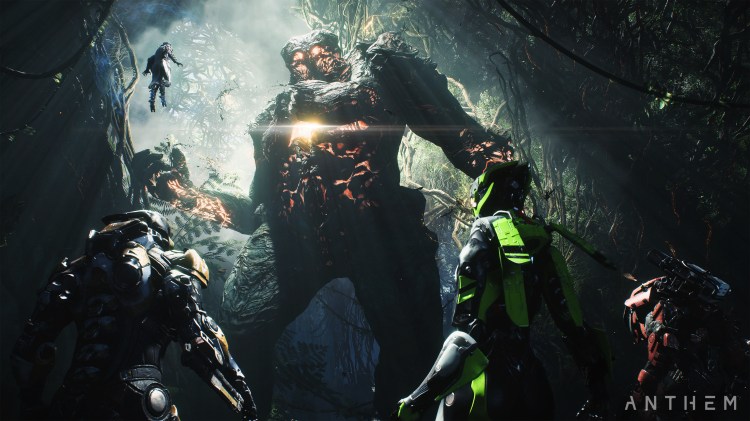When I walked out of “the box” that housed the Anthem demo in the back of the EA Play event last Sunday before the Electronic Entertainment Expo, I couldn’t get over how much fun it was to finally play BioWare’s upcoming cooperative action adventure. I also realized that I still have no idea if this game is going to work as the ongoing live-service game that EA wants.
It’s fun to play. It took me only a couple of minutes to get the hang of flying around like Iron Man and toggling between flying and hovering to fight off roaming bands of creatures. I can’t decide which game had better traversal at E3 between Anthem and Spider-Man, and that should give you an idea of how I feel about EA’s next big release. But these live-service games that you’re supposed to play as a hobby require a lot more than fun gameplay — just ask Destiny 2. Anthem needs a mission and progression structure to go along with its excellent locomotion, and those are elements that are difficult to assess in the first month after a game’s release; let alone in an E3 demo. On top of that, BioWare is bringing along expectations of its own when it comes to narrative and characters.
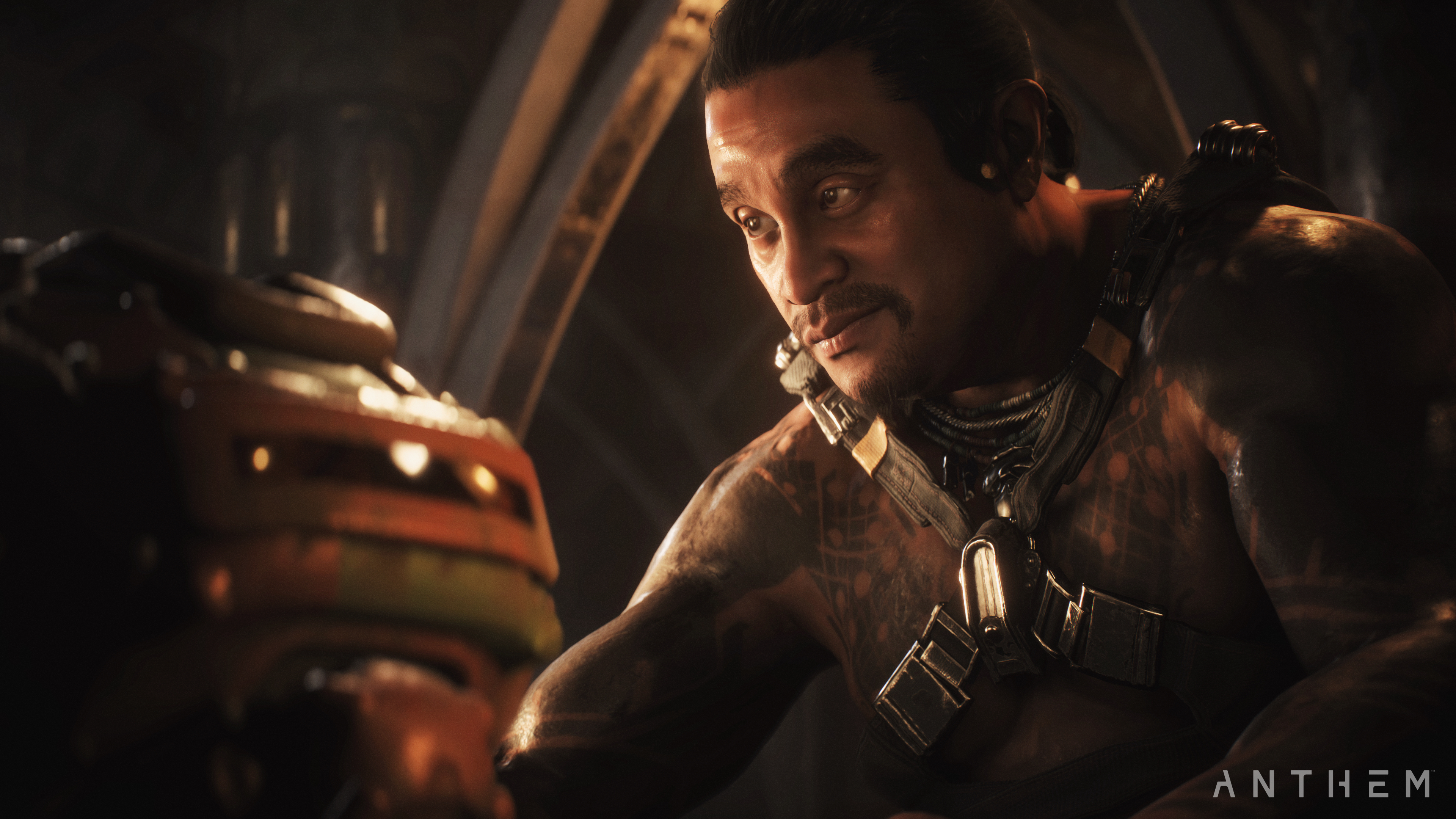
Above: Anthem has characters, and you’ll get to know them in the single-player narrative portion of the game.
This is the studio that made Star Wars: Knights of the Old Republic, Baldur’s Gate, and Mass Effect. It is responsible for some of the most memorable adventures in all of gaming, and EA has not pointed a spotlight on that side of Anthem during its public presentations so far. It did bring back BioWare legend Casey Hudson who left after overseeing the Mass Effect trilogy, and now Hudson oversees the studio. But Hudson’s presence doesn’t mean that Anthem is just more Mass Effect or any other BioWare game. It seems different because it is, and that left me with a lot of questions.
Thankfully, after my demo, Anthem communications boss Brad Hilderbrand led me from one box to another to talk to Anthem game director Jon Warner about my questions and concerns (full disclosure: I used to work with Hilderbrand a long, long time ago at a now-defunct website called Kombo.com). And Warner explained how players will experience the story, which serves multiple purposes and includes a traditional narrative, bursts of plot to serve you online missions, and an environment for creating your own emergent stories.
June 5th: The AI Audit in NYC
Join us next week in NYC to engage with top executive leaders, delving into strategies for auditing AI models to ensure fairness, optimal performance, and ethical compliance across diverse organizations. Secure your attendance for this exclusive invite-only event.
“The initial story of Freelancers versus Dominion, that’s a classic story we’ll tell that has a beginning, middle, and end,” said Warner. “You’ll like it. Then that’s over. But the world conflict will continue on and on. The world of Anthem was abandoned by its gods mid-creation. It’s crazy. It allows us to do this really cool stuff out there. The creatures are big. That’s a conflict we’re never going to solve. It’s never going to be like, and then they finished the world! Nope, no one can do that.”
Warner was clear that his team is putting up some barriers to ensure that you can take ownership over the traditional story. He explained to me how it works, and it involves taking you offline to serve you the kind of experience that BioWare has always made.
“Let’s say you’ve been out just exploring and now you’re ready [to do something structured],” Warner said. “You can pull up the world map, select Fort Tarsis, fast travel back there if you want to, or — I enjoy traversal so much that I usually fly back. Go inside and now that’s a private space for me. This is where I get to see and experience my story without people pestering me.”
https://youtu.be/vsFN4dOnY1o
I got to see Fort Tarsis in my demo. The session started with my character having conversations with well-animated humans who were all oozing personality. BioWare recognizes how everyone felt about the faces in Mass Effect: Andromeda (they were underwhelming and “tired”), and it’s not afraid to put Anthem’s characters right up in your business to show off how natural and lifelike they are.
Since this hub is an offline area, your friends’ choices and actions have no impact on it for you. It is a silo where you get your story. This is also where you get out of your Javelin, which is the name for the mech suits in Anthem, and walk around like anyone else. So you are more flesh-and-blood in these scenes, which should give BioWare a chance to expose some humanity and intimacy — even if it has said that Anthem does not have romanceable characters … yet.
“It’s a very living, breathing community,” said Warner. “There’s a bunch of people. You can walk around, investigate, talk to NPCs, pick up quests, put stuff in your vault, craft, do all this stuff. Then, after you’ve done all that you wanted to do, and you specifically want to get a mission, you can go get that mission and come back to your suit. If you have a loadout you’re happy with, awesome. If not, you can open up the interface that lets you select your suit and tinker with your loadout. Then you go and choose the mission.”
But while BioWare is promising a BioWare story, the lack of romanceable characters seems indicative of how the studio views the purpose of the narrative in its game. The developer wants players to look outward from the hub, not necessarily inward at the depths of the experiences in the hub itself. The focus is on the world beyond the offline zone, and BioWare is building Fort Tarsis and the characters to feed players back into central gameplay loop.
“I think that the main story has a couple of jobs,” Warner explained. “What it needs to do is teach you about the world, the setting, and it needs to teach you how to play the game. Then its job is to anchor content, so that you’re not just going to a bulletin board and pulling down a card that says, go out and kill five dozen scars.”
BioWare has said that it has a content pipeline that will enable it to add new missions with more story at any time. The developer will then use characters whom you like and enjoy working with to give you context to send you back out into the online wild world.
“There’s an engaging way for us to relate that [content] to you because you’re doing missions for this person. You like them. You’ve formed a bit of a relationship with them. You get a little fond,” said Warner. “When they say, ‘hey, I need you to go do this for me,’ you’re thinking, sure, I’ll go do that! It anchors the content that way.”
To put it in plain terms: the story is not The Content in Anthem. And I asked Warner if BioWare misses making games where that was the case.
“Well, I don’t really miss it, because there is that [kind of storytelling] involved as well,” he said. “The critical path is still there. It’s what you think it is. For me as a storyteller this is really exciting because it allows us to tell our story in a really broad manner. And then it allows us to tell new kinds of stories, and it allows us to tell our own stories to each other. That’s awesome. At the core of human experience, you sit around the fire and tell stories. It used to be that you’d tell stories so you didn’t get eaten by creatures.”
If Anthem is successful, we’ll all have stories of dangerous video game creatures to tell each other… but I’m still not sure if Anthem will have what it takes to do that.
Here is my full interview with Anthem director Jon Warner. I spoke with him after playing the game in “the box” behind closed doors at EA Play.
GamesBeat: What is an average play session with Anthem going to be for most people?
Jon Warner: I think that, honestly, there are layers to this. Because right off the bat, when you say, hey, let’s go do something — maybe the whole crew isn’t online yet. Your buddies are doing their thing. You’re by yourself. You’ll just go explore the world for a bit. The map starts shrouded in fog of war, so you can jump out there and just start playing immediately. When you’re doing that, you haven’t selected a mission, you’re just out exploring, the experience — like you noticed today, there’s a lot of interesting decisions you’re making just in traversal. I’m going over here. This is how I’m going to approach this. I’m going to dive down there. There’s some cool stuff going on right off the bat in moving through the world. That’s cool and different and interesting.
Then you’re going to encounter all sorts of interesting scenarios out in the world. It’s dynamic, so it’s not like every time I go off the edge of this waterfall, I know there’s a group of four scars down there and they’re always do this and they’ll drop some of this loot. It’s ever-changing. Maybe it’s there and maybe it’s not. Maybe there’s something different. You jump down there and find a big apex creature instead. There’s always some surprise that’s going on there. Let’s then you get pinged by your buddies to go do a mission. They can invite you right from there. You dive in to their game, and now, as a squad, you’re going after an objective, which is a lot of what you experienced today.
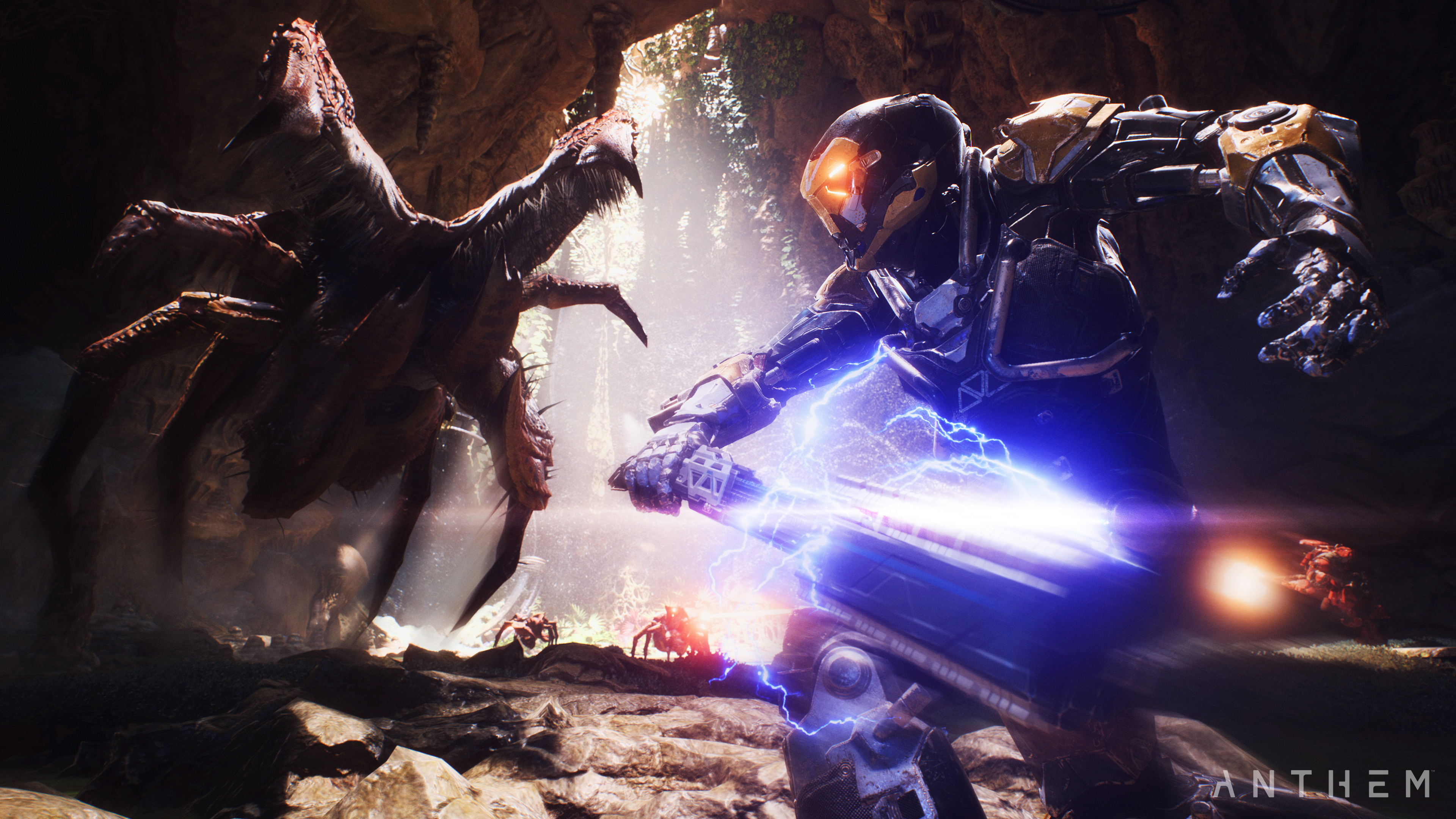
Above: Anthem in action.
GB: What am I going for in exploring the world? Is it loot or some mystery?
Jon Warner: It’s absolutely a loot chase. That’s a key piece of it. There are also crafting materials out there you want to collect. There’s lore. That’s how you’ll discover things about the world. There’s just the joy of exploring it and pushing it back and finding new corners of the map. There are things we call world events that happen out there. That’s where you’re going to be able to — like the big [name – 2:50] that you encountered right before the underwater today. That titan is a world event. You might just be kicking around at that world event can go forward. Other people in the server can jump in and do that, and then you can get back to your mission.
GB: What other interactions are there with other people on the server? Is it usually just world events?
Jon Warner: It depends on what you’re doing. Let’s follow the flow we saw today. You’re in your strider. You’ve decided to go on a mission. You invite your friends. Once you fill up your squad, that’s it. You’re the only ones on that server and you can do what you want. If you’re more in quick play, just jumping in to screw around in the world, then we’ll just put four other people in that instance as well. Then, if you want to go out and play with your friends, you have to invite into their game.
GB: Let’s say I want to do something more structured. Do I fly back to a central hub, or teleport there? What’s that moment like?
Jon Warner: Let’s say you’ve been out just exploring and now you’re ready. You can pull up the world map, select Fort Tarsis, fast travel back there if you want to, or I enjoy traversal so much that I usually fly back. Go inside and now that’s a private space for me. This is where I get to see and experience my story without people pestering me. Inside there, it’s a very living, breathing community. There’s a bunch of people. You can walk around, investigate, talk to NPCs, pick up quests, put stuff in your vault, craft, do all this stuff. Then, after you’ve done all that you wanted to do, and you specifically want to get a mission, you can go get that mission and come back to your suit. If you have a loadout you’re happy with, awesome. If not, you can open up the interface that lets you select your suit and tinker with your loadout. Then you go and choose the mission just like you saw today.
GB: Are the missions story missions first, or is the goal the monster at the end of it? Am I going to say to my friends, let’s go do this mission that has this and this and this, or is it more, let’s go do this legendary titan like Monster Hunter?
Jon Warner: You can approach it either way. You can say, hey, let’s do this story mission, let’s do this side quest, group together and do that. That all has very specific beats. Even so, it won’t be static, like you always encounter the same enemies. It has variability inside there. Weather is variable. A bunch of things in there will make it feel fresh, even though this is the umpteenth time you’ve run the mission, because you’re after a specific piece of loot, a specific thing. That’s one way to look at it, and it will unfold like you expect. Another way is to say, we’re going after something very specific. You saw the stronghold today. Strongholds are purpose built for player expeditions. You would group together. Strongholds is where you want to have more coordination as a group. Although you can jump in with anybody, random people. And the objectives are clearly marked, like you saw. It’s not like you have to all be on voice chat and have communication going on. But if you’re really going after it you can coordinate things like loadouts with your friends. I’m going to bring this suit with this loadout. You bring this suit and that loadout. Get it all tight. Or you could just decide to be crazy and say, let’s all take Storms. We’re going to do this all Storms and then upload that. There’s a bunch of ways to approach it. Variability and choice are part of what keeps that experience fresh.
GB: Can you describe the loop a bit more? Maybe for players just starting off, and then as they progress and become accustomed to the game, how does that loop change over time?
Jon Warner: If you imagine it like concentric circles that are expanding out, that first circle is, I’m going to unlock all the Javelins. That’s kind of your loop if you’re doing story missions. You’ll do side missions to unlock all those suits. That increasing thing of — now I have a lot of uncommon weapons and gear, and now I’m chasing those rares, those epics, those masterworks. It just continues. That fuels the loop as well. But it doesn’t have to be mission-bound. After you play for a decent amount of time, you’re going to then start poking out into repeatable stuff like strongholds. That might be something where, you want to run this stronghold, run that stronghold. But the loop of going out, explore, get loot, get crafting materials, get experience, come back in, level up your pilot, level up your suits by equipping better gear, that continues on.
GB: What’s it like making something that’s different from what you’ve made before? Is it frightening?
Jon Warner: There’s always, in any creative endeavor, some trepidation when you’re trying stuff. But one of the cool things is, our group — the leadership at BioWare and the leadership at EA have been super supportive of this. Creating a new IP is really tough. It’s scary. You have to have the freedom to try things and fail. This design looks perfect on paper, and when you implement it, it’s just not fun. That iteration — there’s an amount of scariness to that, but it’s also pretty exhilarating. And then having a network of leadership around you in the company that’s supportive of the process makes a huge difference.
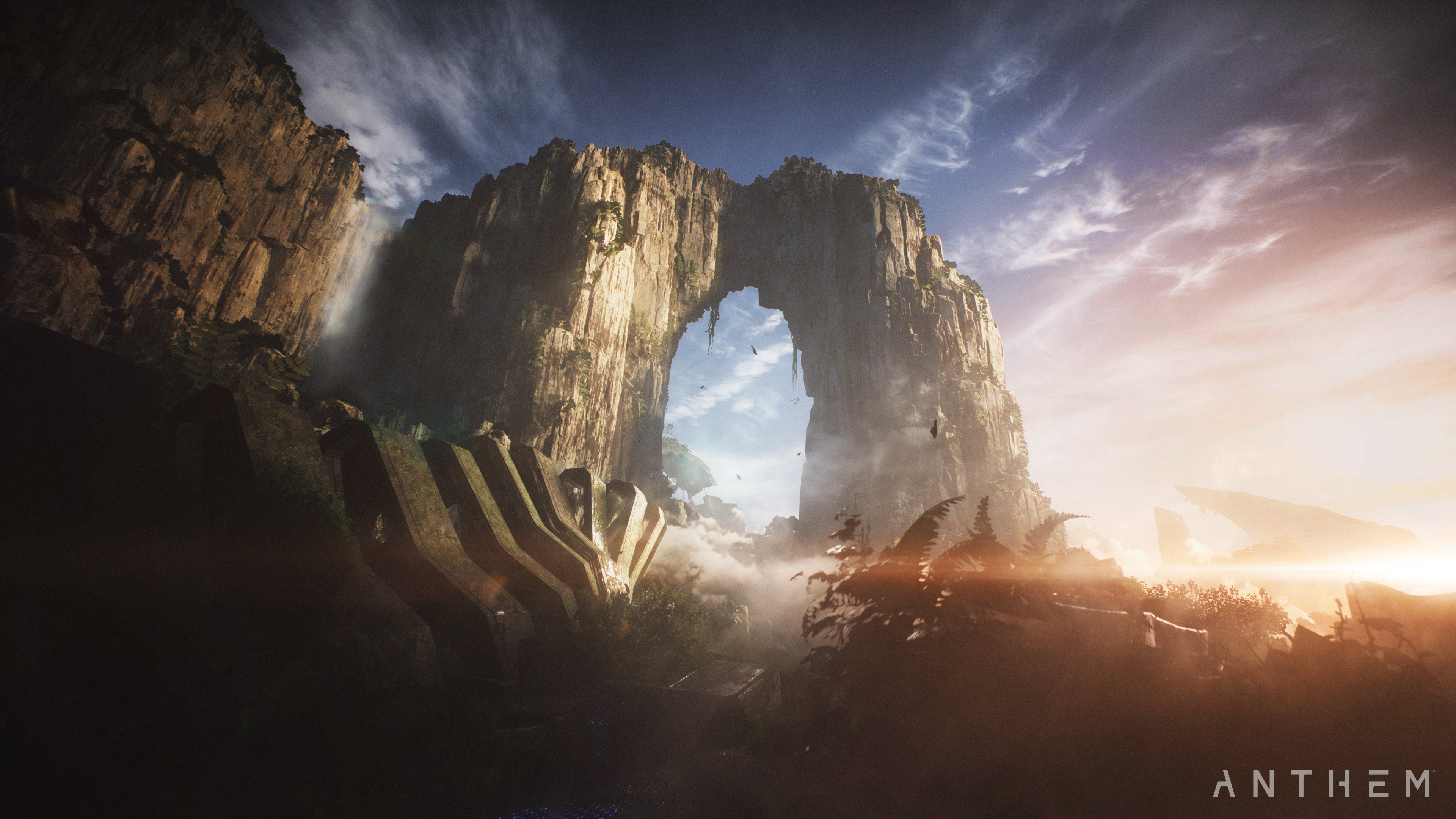
Above: The treacherous landscape of Anthem.
GB: Are there lessons from past BioWare games that are paying off in Anthem?
Jon Warner: I think that, honestly, there’s such a wealth of experience on the team. Team members who worked on Neverwinter Nights and Baldur’s Gate. They have all these experiences — this is how you tell stories, this is how you put together a skill system, a skill tree. All of those things are helpful as you build up and evolve how you tell your story and create your game. That’s been super helpful. And then I think everyone at the studio — we’re avid gamers. We play as much as we can of everything we can.
I used to work at Disney. I made a bunch of platformers. Having some of that background has been interesting as we’ve approached this world in a way that has so much verticality. It’s little surprising insights that people bring to the table.
GB: If I play the game and come away from it, the thing I think you guys nailed first was the traversal – the flying, the jumping, the dashing. And the world feels like it was built around it. Was it exciting to build this world around such great jumping and flying mechanics?
Jon Warner: Absolutely. It’s been very cool to watch our level designers and level artists — it’s unlocked something in their minds. Now we have all of this space to play with, not just this space. It’s been super exciting to approach it this way, because it allows you to do all of these things. We’ve all been playing games for a long time. When you run up against something in a level where you think, I should be able to jump over this, I should be able to climb this, and you can’t–it’s not that it’s frustrating. It just reminds you that you’re playing a game and the designers want you to go this other way. Suddenly, where you’re in a world where you can just leap into the sky and go up, it’s so freeing. It’s freeing from an artistic point of you and from a gameplay point of view.
GB: What was the process of dialing in how the flying feels?
Jon Warner: Oh, it was a huge process, a very long process. We had different conceptions of what it meant and what it could do for our players. At first there was the concern of, well, people will just fly over everything and skip all this great content we’re making. But no, you’re not, because it’s a loot chase. Even flying around, you dive down and do the air melee strike. That was a false worry. Just the evolving nature of taking flying and making it better and better until it got to the point where we just fell in love with it, and all the different suits feeling a bit different in the air, that was so cool.
GB: It feels like this game has to live for a long time. How do you make sure the content you launch with stays fresh, gets people to the point where they want to keep playing, and then how do you make sure you have the ongoing content that’s growing and expanding and keeps people coming back?
Jon Warner: It’s a challenge. A lot of people are grappling with this challenge. Gamers are passionate. When we find something we love, we consume it. There’s a challenge there. The way we try to approach it is by being pretty flexible and pretty dynamic. We’re not relying solely on feeding you new bespoke content. But there’s a dynamism in the world itself that keeps even re-traversal — if you think about this, traverse, re-traverse, mastery. Even if you sit here in the mastery bucket, the moment to moment fun of traversing in your suit still keeps that fresh.
By keeping our ecosystem populated with creatures that are interesting and changing, and being cognizant of the world conditions — at nighttime you’ll encounter certain things in the world, and in the daytime you’ll encounter other things. The weather has an impact on that as well. It keeps things fresh. Because we’re hosting every session on a dedicated server, it allows us to inject content, small pieces of content, things that are impactful and meaningful. I guess that’s a long way of saying, flexibility allows us to pay attention to what the community wants, inject things, try out new things, and then we can come along and do big patches and big packs and things like that.
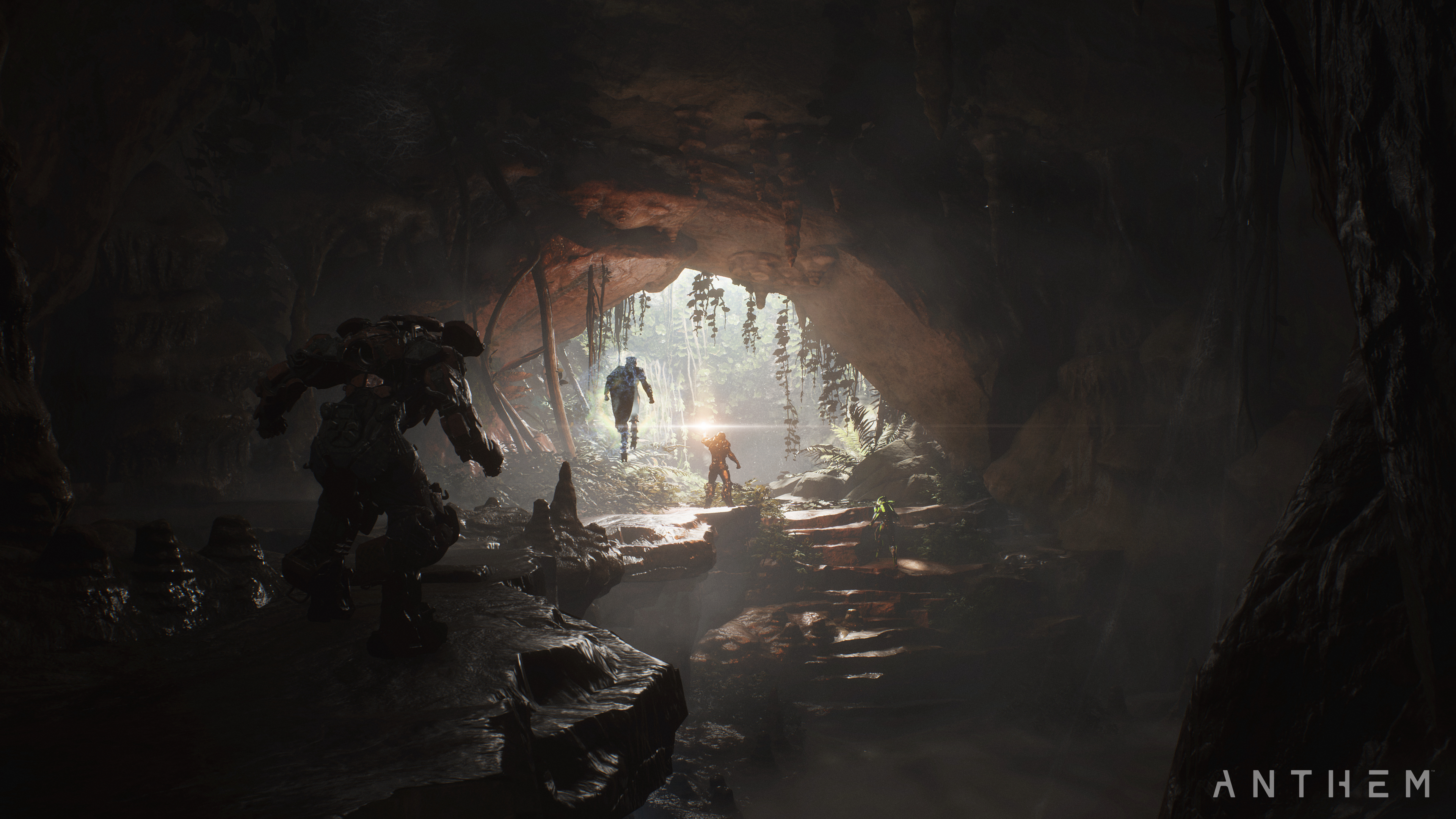
Above: It has dungeons, and I think I also saw some dragons, so ….
GB: So you have an idea of what you want to do and what you can do right now. But if something comes along and you realize there’s this other kind of content or way of changing the game that you didn’t think about, you’re ready to make something like that.
Jon Warner: Exactly. Whenever you release software into the wild, people use it in really surprising ways. If everyone loves it, well, let’s do that. Being able to shift to that is important.
GB: The gameplay opened up with some characters that looked great. They were right up in my face. They had a lot of personality. What is the balance or the emphasis you’re putting on the story as opposed to missions? Do you have a number in mind? Or does it not work like that?
Jon Warner: It doesn’t really work like that for us. I think that the main story has a couple of jobs. What it needs to do is teach you about the world, the setting, and it needs to teach you how to play the game. Then its job is to anchor content, so that you’re not just going to a bulletin board and pulling down a card that says, go out and kill five dozen scars. There’s an engaging way for us to relate that to you, because you’re doing missions for this person. You like them. You’ve formed a bit of a relationship with them. You get a little fond. When they say, hey, I need you to go do this for me, you’re thinking, sure, I’ll go do that! It anchors the content that way.
Then there’s the story that — we have this world story. The initial story of Freelancers versus Dominion, that’s a classic story we’ll tell that has a beginning, middle, and end. You’ll like it. Then that’s over. But the world conflict will continue on and on. The world of Anthem was abandoned by its gods mid-creation. It’s crazy. It allows us to do this really cool stuff out there. The creatures are big. That’s a conflict we’re never going to solve. It’s never going to be like, and then they finished the world! Nope, no one can do that. We have a platform there to tell interesting world stories. And then there’s the stories you tell. You tell them to your buddies. You get back to work or you get together and you say, I was playing last night and I saw this. Again, the cool thing about having this dynamic world we share — let’s say we’re friends, and last night we didn’t group, but we were both on at the same time playing. The next day I can say, hey, did you play Anthem last night? Did you see that huge crazy storm? I did this and this and went over here and found this crazy shaper rune at the bottom of this lake. And then you say, oh, I went here and did this. Now we’re telling each other stories about finding an epic piece of loot or a legendary weapon. That’s another layer of storytelling that we get to engage in.
GB: That’s something different for BioWare, do you think?
Jon Warner: I think so. We’ve dabbled in that, like with Mass Effect 3 multiplayer, and Dragon Age multiplayer, and Andromeda multiplayer for that matter. The idea being, you have these little bites of story, but the story is really about, our squad did this. Because it was a horde mode, it was kind of a story about how long you’re able to last, or how quickly you can accomplish the objectives. In Dragon Age Inquisition it was a step out into this bigger open world where you could start talking about things that happened. I came up over the rise and saw a dragon fighting a giant. This is just another step into that. Now we’re trying to facilitate players telling themselves and each other about cool and interesting experiences.
GB: You said the story anchors the content. Do you miss the story being the content, in a way?
Jon Warner: Well, I don’t really miss it, because there is that involved as well. The critical path is still there. It’s what you think it is. For me as a storyteller this is really exciting because, A, it allows us to tell our story in a really broad manner. And then it allows us to tell new kinds of stories, and it allows us to tell our own stories to each other. That’s awesome. At the core of human experience, you sit around the fire and tell stories. It used to be that you’d tell stories so you didn’t get eaten by creatures.
GB: And now it’s just video game creatures.
Jon Warner: Exactly!
GB: Is there anything else that you wish I’d asked about?
Jon Warner: This is what I’d say to that. I’ve been in the industry for a while. This is the game I’ve always wanted to make. I feel like this is a unique opportunity, because it’s the team I’ve always wanted to make this game with. We’re super passionate about it. When people get their hands on it, they’re going to love it.
GB: Are you feeling confident? It seems like you’re confident about what you have.
Jon Warner: Absolutely. When you have a playable that’s still this early from release, and you’re comfortable giving it to people and letting them have fun with it, yeah.
